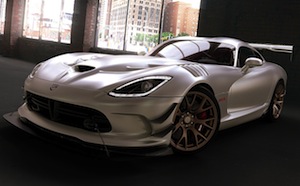 US – Beginning with the 2016 model, the brand will offer matte finishes in a range of hues, making the Viper available in more than 50m configurations, including over 16,000 colour and 48,000 stripe options.
US – Beginning with the 2016 model, the brand will offer matte finishes in a range of hues, making the Viper available in more than 50m configurations, including over 16,000 colour and 48,000 stripe options.
“The Anodized Carbon Viper was the first-ever use of this unique metallic-matte exterior colour by FCA and helped further the trend in automotive matte finish exteriors from the factory,” said Tim Kuniskis, president and CEO, Dodge and SRT brands, FCA US. “Now, by adding 8,000 new matte finish options... we’re continuing at the forefront of the matte paint trend by offering so many variations, colours and even a metallic finish, all of which give each ‘1 of 1’ Viper an even more unique appearance.”
Vipers are hand-painted in a process which lasts up to 145-160 manhours, including preparatory steps. The application of the exterior paint takes around eight hours. First a base coat then a clear finish is applied; next, the body panels are manually sanded with 1,000 grit paper and polished for a smooth look. The new matte finish requires a second round of sanding before the matte clear coat is applied.
All 2016 Dodge Viper models can come with stripes; the GT, GTC, GTS and ACR models offer optional GTS stripes running from the front to the rear fascia, while the SRT and GTC models are available with SRT stripes from the clamshell hood to the rear hatch via the roof; the GTC and ACR offer the ACR centre band and driver’s side stripe.
Nose-to-tail stripes are hand-painted and finished underneath the clear coat or matte clear finish – unlike many cars which use decals – therefore preventing any discernable edges. Adding 18 hours to the overall paint process, each stripe is applied in the paint booth before the main body colour. Once the paint is cured, a final coat ensures that the stripes are properly integrated into the finished vehicle.






























